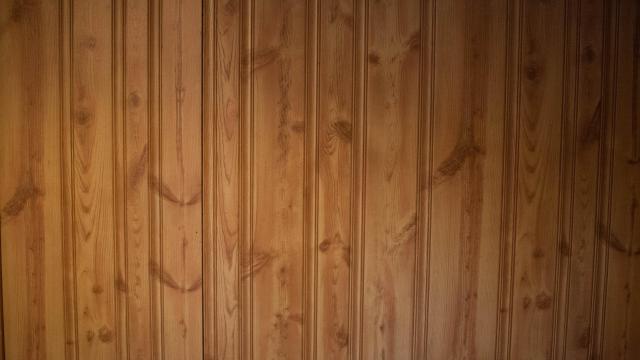Every decade has a “look.” You can turn on any random film or TV show and instantly know what era the story takes place in based solely on the fashions people are wearing and the decor of their homes. One of the easiest decades to spot in terms of home decor is the 1970s — there are simply so many design signifiers to look for, from shag carpeting and sunken living rooms to garish patterns and, for some reason, the colour orange. That’s the way of interior design — what once looked super modern and chic slowly becomes dated and very, very uncool (and then, sometimes, comes all the way back around to cool again).
One feature that screams 1970s is wood panelling. Once seen as a budget-friendly and durable material, wood went out of style a long time ago and so far, no one has tried very hard to bring it back. If you have wood panelling in your home and you’d like to get rid of it in favour of a more modern look, you may have come up against a harsh reality: Wood panelling can be a real pain to get rid of. If you have a 1970s time capsule in your home you want to put behind you, here are your options for getting rid of that wood panelling.
Can you tear out wood panelling?
Option one, of course, is to physically remove the panelling and then either replace or repair the walls. This can be a lot more work than you might expect; often glued directly to the wall, removing wood panelling can be difficult work if you’re trying to preserve the wall underneath it (in order to avoid having to hang fresh drywall). If the panels are glued down, getting a prybar under them will be a job in itself, and you will very likely damage the drywall in the attempt — possibly beyond redemption. If the panels are attached directly to the studs without any drywall layer, you might have an easier time depending on how enthusiastic the installers were with the nails, but you’ll still have to install drywall. In other words, whatever hopes and dreams you have of removing the panelling and simply rehabbing the walls are probably not going to happen — you’ll have to replace the whole wall.
Another reason to be leery of removing old panelling? It was often used to hide problems. Water damage, enormous holes, ancient, crumbling plaster? Much easier and less expensive to just cover it with panelling and leave the real problem for a future owner. Do you want to be that future owner?
How to cover up wood panelling
If tearing out your wood panelling is a no-go either because of the mess and stress or because you need to keep the reno project small-scale and budget-friendly, you can try covering the wood panelling:
- Paint. Painting wood panelling a light colour can make it much less noticeable. Clean your panels thoroughly, then sand them lightly using a fine-grit sandpaper — you can often skip sanding and be totally fine as long as you prime the wall before painting, but sanding it will guarantee a much better painting experience as it will get rid of the shiny surface gloss that inhibits paint from adhering. Then fill in any holes or gaps with caulk, prime the surface, and paint the wall with your chosen colour.
- Wallpaper. If you want a pattern on your walls, you can cover wood panelling with wallpaper. It’s best to use a wallpaper liner first; this provides a flat, smooth surface for your wallpaper to adhere to, and also prevents shrinkage as the paste dries, keeping your seams tight.
How to make your wood panelling…disappear
Finally, you have the option of performing an interior design magic trick: Make your wood panelling disappear entirely by filling in the gaps and then painting. Prep the walls for paint, then take some standard joint compound and fill in the joints. This will take at least two applications with some sanding in-between to get them smooth and flush with the rest of your panels.
Then, if your panels have a wood grain to them, you’ll probably need a skim coat. A skim coat involves watering down joint compound and then “painting” it on, followed by smoothing with a trowel. It can take two or more repetitions to get a nice, smooth look, but once you’re done your walls will look like standard drywall, and you can prime and paint them as you would with any other wall in your home.
Of course, it’s OK to just learn to love your wood panelling — especially once you learn how much trouble it is to get rid of.

Leave a Reply
You must be logged in to post a comment.